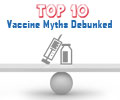Each year, about 40,000 children are born infected with human cytomegalovirus, or CMV, and about 8,000 of these children suffer permanent disabilities due to the virus
Each year, about 40,000 children are born infected with human cytomegalovirus, or CMV, and about 8,000 of these children suffer permanent disabilities due to the virus – almost one an hour. These disabilities can include hearing loss, vision loss, mental disability, a lack of coordination, and seizures. According to the Centers for Disease Control and Prevention, CMV is as common a cause of serious disability as Down syndrome, fetal alcohol syndrome, or neural tube defects.
Because of the dangers posed by the virus to infants, the Institute of Medicine has declared that development of a CMV vaccine should be one of the highest priorities for vaccine makers. Now, in a new study in the August 1 issue of The Journal of Virology, researchers at The Wistar Institute outline an innovative approach that could be used to create such a vaccine.The Wistar scientists began with the observation that mice harbor a species-specific form of CMV that is unable to sustain an infection in humans and is completely harmless to them. They then asked whether, using recombinant technologies, there might not be a way to shift the mouse-specific virus closer to the human-specific virus to generate a version of the virus able to elicit a protective immune response but not a dangerous infection in humans.
With this goal, the researchers began to systematically introduce selected genes from human CMV into the genome of mouse CMV in the laboratory. The result was a novel form of CMV virus that infected human cells well enough that it might trigger an immune response but not well enough to sustain an infection.
“It should be possible to develop a safe and effective CMV vaccine using the method we’ve described in our study,” says Gerd G. Maul, Ph.D., a professor in the Gene Expression and Regulation Program at Wistar and senior author on the new study. “Success will depend on achieving a certain balance between the immune-stimulating genes from the human virus and the basic safety of the mouse virus.”
Over the years, a number of scientists have worked to create a vaccine against human CMV. Among these is former Wistar researcher Stanley A. Plotkin, M.D., who during his career at the Institute between 1960 and 1991 developed the rubella vaccine that eradicated the disease in the U.S. and co-developed a new rotavirus vaccine approved in the U.S. in 2006. Plotkin’s approach to developing a CMV vaccine was to attenuate, or weaken, human CMV, as he had done to create the rubella vaccine. In contrast, the rotavirus vaccine was developed using co-infection techniques to incorporate selected elements from several human rotavirus strains into a bovine rotavirus backbone. The vaccine that resulted takes advantage of the immunological characteristics of both the human and bovine viruses. This approach is conceptually similar to Maul’s strategy for developing a CMV vaccine, although the recombinant technologies available today should help to streamline the task.
CMV infection is widespread in the U.S., according to the Centers for Disease Control and Prevention. Between 50 and 80 percent of adults are infected with CMV by the time they reach 40 years of age, but the virus generally poses little threat to them. The exceptions are AIDS patients, transplant recipients, and others with compromised immune systems are at risk for complications. The virus is a member of the herpes virus family, which includes the herpes simplex viruses, the viruses that cause chicken pox (varicella-zoster virus), and infectious mononucleosis (Epstein-Barr virus.) Infectious transmission is via body fluids.
Advertisement







